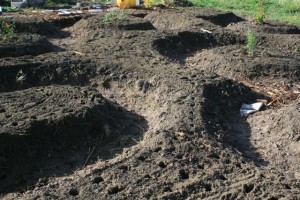My garden is boring. I came to this realization one stormy day a year ago in February, a time when most plants were brown and shriveled, and only the weeds stood tall and green. I wrote about it in a blogpost about Self-Imposed Limitations, Sustainability, and Creatively Breaking Rules. I didn’t take pictures. I mean, how do you capture boring – and is that something you really want to share?
Being able to see the naked bones of the garden like that, though, can be quite an eye-opener – kind of like standing nude in front of the mirror and admitting you really should start working out (as in, something’s gotta change here). Course, we don’t notice it so much in the summer when everything is clothed in flowers. The worst part was, though, I realized it was not just boring; it was conservatively conventional, words that are almost blasphemy to my creative being.

Ok. I admit. My garden is very structured. Rows within rectangles within squares. Orderly. Clean. Neat. Ultimately linear. I stress over weeds. They disrupt the order. A lot of people really like that sort of thing. It’s organized.
Other parts of my life? Not so much.
I was considered a bit radical back in the 70s when I experimented with the French Intensive methods promoted by early Organic Gardening magazines. I had recently returned from a stint as a foreign exchange student in Paris, so I thought I was pretty legit. My neighbors, though, wondered whether I had buried my dogs out there in the raised beds.
It might seem a bit odd, then, that someone who has long subscribed to the motto, “Question Authority,” never really questioned conventional wisdom when it came to gardening. Like canning peaches and making strawberry jam, certain things are passed down through generations, and they seem good just the way they are. Real good, in fact.
There is usually a good reason that things are done “the way they always have been.” Efficiency and convenience are two adjectives that come to mind: rows the width of a tiller, tractor, mower, or wheelbarrow. Ease of watering, weeding, and harvest. Knowing where things are might be important (ahm).

On this particular windy day that was shaking my belief foundations, however, I came to the “ah-ha!” moment when I realized that nothing in nature grows in rows. Like, duh. It’s more of an organized chaos. Now ThatI can relate to!
Looking at the weathered skeletons of the previous year’s vegetables interspersed with clumps of grass, it struck me that the difference between nature, a farm, and a garden is not just one of order and scale.
I also realized that my little backyard universe fell into the “none-of-the-above” category. Too small for a real farm; too structured to really be called a garden, which I think of as an artistic retreat expressed in a riot of colorful flowers (Tell me, why are a lot of colors always in a riot?).
Sure, we could call it a “hobby farm,” a term that I dislike because it sounds like a person doesn’t take it very seriously – and I am very serious about growing 24 varieties of garlic! But it’s basically too small for a tractor and it’s a lot of work with just a shovel. I have a lot of mixed feelings about a tiller, because it violently massacres worms, which are my friends, so I rarely use one.
Ok – so maybe the more appropriate term would be a “veggie garden,” which, in my experience, is traditionally a place of toil and trouble. These are tightly controlled spaces where people focus on succession planning and efficiency evaluations. It’s all about timing. Conditioning. Nurturing. Weeding weeding weeding. Harvesting. Processing. These words all sound like work to me, but at least you are (sometimes) rewarded for the effort.
And on the other extreme is nature — grand scale, everything grows, no work involved. The plants grow every which-way – up, down, around, and through. They support one another in their diversity. Rarely do you see a lot of insect damage. Slugs on the trail, sure, but not under every leaf. No one is out there with a rake, a hose, and a bag of bone meal, and everything is prolific without them.
Hmm. What is wrong with this picture? Or should I say, “right?”
I might grow a lot of different things, and I’ve always been a big believer in companion planting, but I realized with a certain amount of consternation that my garden was really just a series of little monocultures.
Some of this is necessitated by the garlic operation, a crop of around 1000 bulbs, more or less, depending on the year, that is rotated around six 25-square-foot plots. The rotation is important to prevent disease. In the off-years, I alternate between building the soil with green manures and growing an assortment of veggie crops for friends, family, and strangers, depending on who is willing to take the zucchini. Yes, it’s bigger than the average garden, but not quite up there with the farming league. A lot of work with a hoe and a shovel; not enough to warrant firing up a tractor.
I was contemplating this lifestyle when I came across Gaia’s Garden, Second Edition by Toby Hemenway. It was an “Ah Ha!” moment for me. A complete garden-changer. Seriously. This book completely altered my way of thinking about the way I grow things and my relationship to plants (this link provides a long review). I still refer to it again and again.
The short synopsis is that it is about looking at your garden as an ecosystem, not a series of compartments; it’s about working with nature to optimize that system.
I have previously written about the folly of my attempt to patrol and control the borders of my garden, a militaristic viewpoint at best, where I was constantly at war with the weeds around me – and believe me, I was surrounded.
Through this book, I realized that weeds are not the enemy. They are, in fact, a resource. Allow some to thrive, and they will provide innumerable benefits. Cut some back, and they will still provide innumerable benefits. It’s all good.

It was in this Kumbaya moment that I decided to try a little horticultural experiment to transform our back acre into something much more than a garlic merry-go-round. Life – including plant life – travels through this timezone in circles, after all, not rectangles. Paths may appear straight-forward, but that doesn’t mean that they are.
Maybe it’s an age thing. It is hard to write about gardening without also writing about life; there are so many correlations. Gardens are always changing – through the seasons, over the years, according to vision, design, or whatever you are willing (or not willing) to let go of. There are infinite possibilities, certainly too many to contemplate in one lifetime. (As in, “Yes, Mother, I know, ‘It’s all about choices’.”)

Perhaps it was time to get smarter about the gardening. I have a tendency to make things overly complicated (or so I’ve been told), and according to Nature, I have been working waaay too hard at this. After all, I am officially a grandmother now, 5 times over. I never thought I would ever write those words, much less contemplate traveling across the country in a travel trailer and staking up a pink flamingo in a park in Florida. Ha! Actually, I’m joking. I have a pink flamingo right here at home – why would I need another in FL?
But as the grains slip more quickly through the hourglass, we think about what else we might want to do, aside from watching them form those cool little pyramids in the bottom. I mean, there might come a time when I might need to phase out the garlic if there is no one else to carry on the legacy (I know, I know – those are strong words!). And maybe there is something else I might like to leave behind – like, for instance – a jungle.

It’s not that far-fetched. We have a jungle, also known as the Olympic Rainforest, just a couple hour drive from here. Course, we don’t get the rain here in the Olympic rainshadow of Sequim (classified as semi-desert) that they get in the Twilight zone of Forks – but with a little planning and a lot of mulch, a food forest, as opposed to a rainforest, is very much a possibility. I like the idea of sitting in the middle of my very own patch of blueberries and eating them until I am blue in the face. Now That is my idea of a retreat!
And with that idea, thus began my journey into the food forest, one that I am creating as I go. I am a year into it and adding on with every season. The sharp borders between garden, farm, and sanctuary are becoming blurred every step of the way.

Did you wonder what wild hair motivated me to plant my garlic in such crazy circles? Rest assured, there is a method to my madness. And it just keeps getting crazier – and at the same time, so much saner. I might have to start wearing purple. I kind of like getting old and crazy. Maybe I need a dozen cats. And a hot-air balloon. At the very least, a pair of red dancing shoes with sparkles on them.
And a jungle to dance in. Yes.
Stay tuned.
